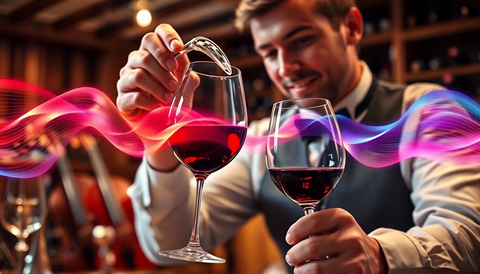Wine has long been associated with romance, from the intimate candlelit dinners to the soft clinking of glasses as couples toast to their love. But how did this fermented grape juice become the quintessential drink of romance? Let's explore the fascinating history and cultural significance of wine's romantic allure.
The Origins of Wine's Romantic Appeal
The origins of wine's romantic appeal can be traced back to ancient civilizations. In ancient Greece, wine was closely tied to the worship of Dionysus, the god of wine, fertility, and ritual madness. Dionysian festivals were marked by ecstatic celebrations, where wine flowed freely, and inhibitions were cast aside. This association with the divine and the primal connected wine to the realm of the sensual and the romantic.
Similarly, in ancient Rome, wine was not just a beverage but a symbol of luxury, sophistication, and indulgence. The wealthy elite would gather for lavish banquets, where wine was served alongside sumptuous dishes and accompanied by music, poetry, and lively conversation. These social gatherings fostered an atmosphere of intimacy and romance, further cementing wine's status as the drink of choice for the discerning and the amorous.
The Romantic Poets and Wine
As the centuries passed, wine's romantic allure found its way into the works of some of the most renowned poets and writers. The Romantic poets of the 19th century, in particular, were enamored with the sensual and emotional qualities of wine.
Lord Byron, the quintessential Romantic poet, often waxed poetic about the intoxicating effects of wine. In his poem "The Giaour," he writes, "Fill the cup, and fill the can; / The Chian and the Teian grape / Grow not those drops of heaven's nectar, / The flowers and fruits of love's own tree." Byron's vivid descriptions of wine's ability to transport the drinker to a realm of heightened emotions and sensations captured the Romantic spirit of the age.
Similarly, John Keats, another celebrated Romantic poet, drew parallels between the richness of wine and the depths of human experience. In his ode "Ode to a Nightingale," Keats famously writes, "O, for a draught of vintage! that hath been / Cool'd a long age in the deep-delved earth, / Tasting of Flora and the country green, / Dance, and Provençal song, and sunburnt mirth!" The imagery of wine as a gateway to a world of sensual delights and poetic inspiration resonated with the Romantic movement's emphasis on emotion and the power of the imagination.
The Romantic Dinner and Wine
As the 19th century gave way to the 20th, the association between wine and romance became firmly entrenched in Western culture. The romantic dinner, complete with candlelight, soft music, and a bottle of fine wine, became a quintessential symbol of courtship and intimacy.
The pairing of wine with a carefully curated meal elevated the dining experience to a sensual and emotional level. The ritual of selecting the perfect wine to complement the flavors of the food, the slow sipping and savoring of each sip, and the shared experience of enjoying the meal together all contributed to the romantic ambiance.
Moreover, the act of sharing a bottle of wine with a loved one fostered a sense of intimacy and connection. The act of pouring, swirling, and tasting the wine together became a symbolic gesture of trust, vulnerability, and the sharing of a moment in time.
The Enduring Allure of Wine
Today, wine's romantic appeal continues to captivate and inspire. From the rolling vineyards of Tuscany to the sun-drenched slopes of Napa Valley, wine has become inextricably linked to the pursuit of love and the celebration of life's most cherished moments.
Whether it's a first date, an anniversary celebration, or a proposal over a candlelit dinner, wine has the power to elevate the experience, creating an atmosphere of intimacy, sensuality, and shared joy. The ritual of selecting the perfect bottle, the anticipation of uncorking it, and the savoring of each sip all contribute to the romantic allure of wine.
Moreover, the world of wine has become a realm of exploration and discovery, where couples can embark on wine-tasting adventures, learn about the nuances of different varietals, and create shared memories that deepen their connection.
In the end, wine's enduring status as the drink of romance is a testament to its ability to capture the essence of human emotion and the pursuit of love. From the ancient Dionysian festivals to the modern-day romantic dinner, wine has remained a constant companion in the timeless dance of romance.
Conclusion
Wine's romantic allure is a multifaceted and enduring phenomenon, rooted in the rich history and cultural significance of this ancient beverage. From its associations with the divine and the sensual to its role in fostering intimate connections and shared experiences, wine has become the quintessential drink of romance.
As we raise a glass to the enduring power of wine, let us celebrate the ways in which this remarkable liquid has the ability to transport us to realms of heightened emotion, sensuality, and the pursuit of love. Whether it's a candlelit dinner, a picnic in the vineyard, or a cozy night by the fireplace, wine will always be there to add a touch of romance to our lives.



Comments (0)
There are no comments for this article. Be the first one to leave a message!